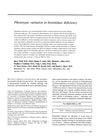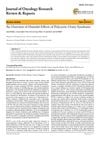Search
for
Sort by
Research
180-210 / 819 resultsresearch A Hairy Problem

research Surgical Management Of Scarring Alopecia
Hair loss due to scarring can be treated by reducing inflammation, removing scar tissue, and transplanting hair. The Follicular Unit Extraction technique is effective but requires skill and time. Future focus should be on scar-less healing methods.
research New Developments in Our Understanding of Acne Pathogenesis and Treatment
We now understand more about what causes acne and this could lead to better, more personalized treatments.
research LC/MS Analysis of Stratum Corneum Lipids: Ceramide Profiling and Discovery
A new, quick method was developed to analyze skin lipids, discovering a new ceramide subclass.

research Hair Matrix Germinative Epidermal Cells Confer Follicle-Inducing Capabilities on Dermal Sheath and High Passage Papilla Cells
Hair growth can be stimulated by combining certain skin cells, which can rejuvenate old cells and cause them to specialize in hair follicle creation.

research Targeting Integrin Pathways: Mechanisms and Advances in Therapy
New therapies are being developed that target integrin pathways to treat various diseases.
research In Search of New Therapeutics: Molecular Aspects of the PCOS Pathophysiology - Genetics, Hormones, Metabolism and Beyond
New treatments are needed for PCOS that target its genetic, hormonal, and metabolic causes.

research Genetic Hair Disorders: A Review
The conclusion is that genetic testing is important for diagnosing and treating various genetic hair disorders.
research Synthesis of Porcine pCLCA2 Protein During Late Differentiation of Keratinocytes of Epidermis and Hair Follicle Inner Root Sheath
pCLCA2 protein may help maintain skin structure and function.

research SOX9 in Organogenesis: Shared and Unique Transcriptional Functions
SOX9 is essential for the development of various organs and hair follicles.
research Transcriptome Profiling and Differential Gene Expression in Canine Microdissected Anagen and Telogen Hair Follicles and Interfollicular Epidermis
Different genes are active in dogs' hair growth and skin, similar to humans, which helps understand dog skin and hair diseases and can relate to human conditions.
research Overexpression of Hepatoma-Derived Growth Factor in Melanocytes Does Not Lead to Oncogenic Transformation
Overexpression of HDGF in melanocytes does not cause cancer.

research A Hairy Situation: PADIs in Regeneration and Alopecia
Enzymes called PADIs play a key role in hair growth and loss.
research The Developmental and Molecular Requirements for Ensuring That Human Pluripotent Stem Cell-Derived Hair Follicle Bulge Stem Cells Have Acquired Competence for Hair Follicle Generation Following Transplantation
Scientists found the best time to transplant human stem cells for hair growth is between days 16-18 when they have the right markers and growth potential.

research Autologous Platelet and Extracellular Vesicle-Rich Plasma as Therapeutic Fluid: A Review
Autologous Platelet and Extracellular Vesicle-Rich Plasma (PVRP) has potential in enhancing tissue regeneration and improving hair conditions, but its effectiveness varies due to individual differences.
research Frontal Fibrosing Alopecia and Reproductive Health: Assessing the Role of Sex Hormones in Disease Development
Hormonal imbalances during menopause may significantly contribute to Frontal Fibrosing Alopecia.

research Asian Female Hairline Surgery Using Follicular Unit Extraction
The FUE technique is effective for Asian female hairline restoration with benefits like no scar and short recovery time.

research Applications of Human Pluripotent Stem Cell-Derived Skin Organoids in Dermatology
Skin organoids from stem cells can help study and treat skin issues but face some challenges.
research A Recently Characterized, Underdiagnosed Cause of Female Androgenetic Alopecia and Polycystic Ovarian Syndrome: Non-Classical 21 Hydroxylase Deficiency
Non-classical 21 hydroxylase deficiency is an underdiagnosed cause of female hair loss and polycystic ovarian syndrome.
research Ligand-Independent Vitamin D Receptor Actions Essential for Keratinocyte Homeostasis in the Skin
Non-liganded Vitamin D Receptor is crucial for healthy skin and hair.

research Central Precocious Puberty Secondary to Peripheral Precocious Puberty Due to a Pineal Germ Cell Tumor: A Case and Review of Literature
A pineal tumor caused a boy's early puberty, which changed from peripheral to central after treatment.

research Rare Cutaneous Side Effects of Imiquimod: A Review on Its Mechanisms, Diagnosis, and Management
Imiquimod can cause rare skin side effects, some irreversible, and long-term follow-up is important for users.

research Conference 2022, The Sequel
The document encourages attending the 2023 Dermatology Nurses' Association Convention.

research Understanding the Intricate Pathophysiology of Psoriasis and Related Skin Disorders
Psoriasis involves immune and genetic factors, and understanding these can improve treatments.
research Phenotypic Characterization of Patients with Polycystic Ovary Syndrome in a Population from the Ecuadorian Andes: A Cross-Sectional Study
Classical PCOS types A and B are most common and linked to higher health risks.

research Postmenopausal Hyperandrogenism Due to Ovarian Hyperthecosis
A woman's high testosterone levels and related symptoms improved after ovary removal surgery.

research Phenotypic Variation in Biotinidase Deficiency
Biotinidase deficiency has various symptoms and can be treated with biotin supplements.

research An Overview of Harmful Effects of Polycystic Ovary Syndrome
Polycystic Ovary Syndrome (PCOS) can lead to diabetes, heart disease, cancer, and mental health problems.

research Epidermal-Dermal Coupled Spheroids Are Important for Tissue Pattern Regeneration in Reconstituted Skin Explant Cultures
Skin spheroids with both outer and inner layers are key for regrowing skin patterns and hair.